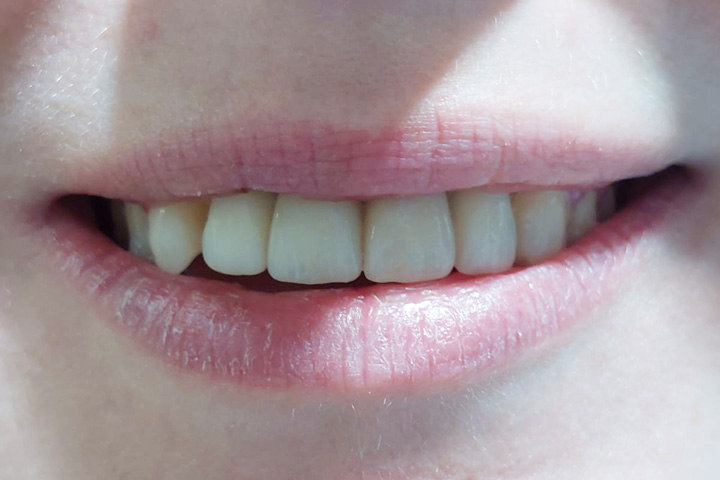Wie funktioniert ein Sinuslift?
Sinuslift OP
Im Vorfeld jeder Sinuslift-OP erfolgt bei Euerzahnarzt Klinik eine gründliche Diagnose. Bei dieser stellt der Kieferchirurg mithilfe des 3D-Röntgen fest, ob ein Knochenaufbau notwendig ist. Und falls ja, wie viel Knochenvolumen für eine erfolgreiche Implantation benötigt wird. Davon hängt nämlich die Wahl der OP-Methode ab.
Während der OP macht der Kieferchirurg den Sinusboden über eine kleine Öffnung zugänglich . Mit speziellen Instrumenten löst er oder sie durch diese Öffnung den Sinusboden vorsichtig vom Knochen und hebt ihn an. Dadurch entsteht ein Hohlraum, in den man das Knochenersatzmaterial hineinfüllt. Nach der OP lagert sich der natürliche Knochen an dieses Material an und verwächst damit.
Es gibt dabei zwei unterschiedliche Vorgehensweisen: der interne bzw. geschlossene Sinuslift und der externe bzw. offene Sinuslift. Welche Methode zum Einsatz kommt, hängt vom Knochenangebot ab.
Eine Sinuslift-OP besteht aus drei Schritten:
- Diagnostik
- Wahl der Methode – intern vs. extern
- Durchführung der OP
Im Folgenden schauen wir uns die Unterschiede zwischen internem und externem Sinuslift einmal genauer an:
Interne Methode
Ein interner Sinuslift ist sozusagen die einfachere Variante. Sie kommt zum Einsatz, wenn nur wenige Millimeter Knochenhöhe fehlen, um das Implantat fest zu verankern. Das Verfahren ist minimalinvasiv, da der Zugang zur Kieferhöhle direkt über das Bohrloch für das Implantat erfolgt.
Der Kanal wird in diesem Fall nicht auf die komplette Länge des Implantats gebohrt, sondern nur bis zu dem Punkt, wo der knöcherne Sinusboden endet. Hier sitzt eine Schleimhaut, welche die Mundhöhle von der Kieferhöhle trennt. Mit einem speziellen Instrument wird der Knochen aufbereitet und anschließend die Schleimhaut von innen leicht angehoben.
In den so entstandenen Hohlraum kommt das Knochenersatzmaterial. Anschließend kann man direkt das Implantat in das Bohrloch setzen.
Der große Vorteil bei diesem Verfahren ist, dass Sinuslift und Implantation über denselben Operationsbereich erfolgen können. Das Vorgehen ist daher minimalinvasiv und es sind nur sehr geringe postoperative Beschwerden zu erwarten.
Der Nachteil ist jedoch, dass man mit dieser Methode nur wenige Millimeter fehlenden Knochens ausgleichen kann. Hat sich der Knochen bereits weit zurückgebildet und es müssen mehrere Millimeter ersetzt werden, muss der externe Sinuslift zum Einsatz kommen:
Externe Methode
Ein externer Sinuslift ist aufwendiger als die interne Methode, aber dennoch ein sicheres und erfolgversprechendes Vorgehen. Müssen mehrere Millimeter Knochenhöhe für das Setzen der Implantate gewonnen werden, ist dieses Verfahren unumgänglich.
Hierbei gelangt der Kieferchirurg nicht von innen an den Kieferknochen, sondern von außen. Seitlich oben im Kiefer wird zunächst die Schleimhaut geöffnet und dann die Kieferhöhlenwand freigelegt. Man spricht auch von „Fensterung“, weil eine Art Fenster in den Knochen gebohrt wird. Dabei kommen feine Spezialinstrumente zum Einsatz. Die Schleimhaut zwischen dem Knochen und der Kieferhöhle wird dabei nicht verletzt. Sie wird mit stumpfen Instrumenten vorsichtig angehoben, bis ein Hohlraum zwischen dieser Membran und der Knochenplatte entsteht.
In dieses Loch wird anschließend das Knochenersatzmaterial eingefüllt, genau wie beim internen Sinuslift. Eine Membran verschließt das im Knochen eröffnete „Fenster“, so dass sich der Knochen ungestört bilden kann. Die Membran ist resorbierbar, der Körper baut sie also von selbst vollständig ab.
Werden während der OP mindestens 3 bis 5 Millimeter Knochenhöhe gewonnen, können unter Umständen die Implantate zeitgleich eingesetzt werden. Ist der Knochen jedoch bereits stärker geschädigt, ist es in den meisten Fällen sicherer, den Knochenaufbau erst einheilen zu lassen und die Implantate dann zu setzen.
Der externe Sinuslift ist zwar umfangreicher als das interne Verfahren, doch muss man mehrere Zähne ersetzen oder ist nur noch sehr wenig Kieferknochen vorhanden, ist diese OP eine hervorragende Methode, um überhaupt noch festsitzenden Zahnersatz möglich zu machen.
Sinuslift und Implantat gleichzeitig
Können also Sinuslift und Implantate gleichzeitig gesetzt werden? Die Antwort ist: es kommt darauf an.
Fehlen nur wenige Millimeter im Knochen, um den Implantaten stabilen Halt zu geben, kommt meist die interne Methode zum Einsatz, bei der das Implantat gleichzeitig mit eingesetzt wird. Aber auch beim externen Vorgehen kann unter Umständen schon genügend Knochen gewonnen werden, um das Implantat direkt zu setzen. Werden Sinuslift und Implantation gleichzeitig durchgeführt, spricht man generell von einem „einzeitigen Sinuslift“.
Manchmal ist der noch vorhandene Knochen jedoch schon so weit abgebaut, dass er selbst mit Knochenaufbau nicht sofort in der Lage ist, ein Implantat zu halten. In diesem Fall muss das Knochenersatzmaterial erst einheilen und mit dem körpereigenen Knochen verwachsen, bis genügend Stabilität für ein Implantat gegeben ist. Man spricht von einem „zweizeitigen Sinuslift“.
Knochenersatzmaterial
Das Knochenersatzmaterial, das wir bei Euerzahnarzt Klinik für die Operation verwenden, ist von der Marke Bio Oss. Seit über 20 Jahren wird dieses Material erfolgreich in der Praxis eingesetzt und auch wir haben nur sehr gute Erfahrungen damit gemacht. Die Struktur der Poren ist derjenigen von menschlichem Knochen sehr ähnlich und kann dadurch hervorragend mit dem körpereigenen Knochen verwachsen.





